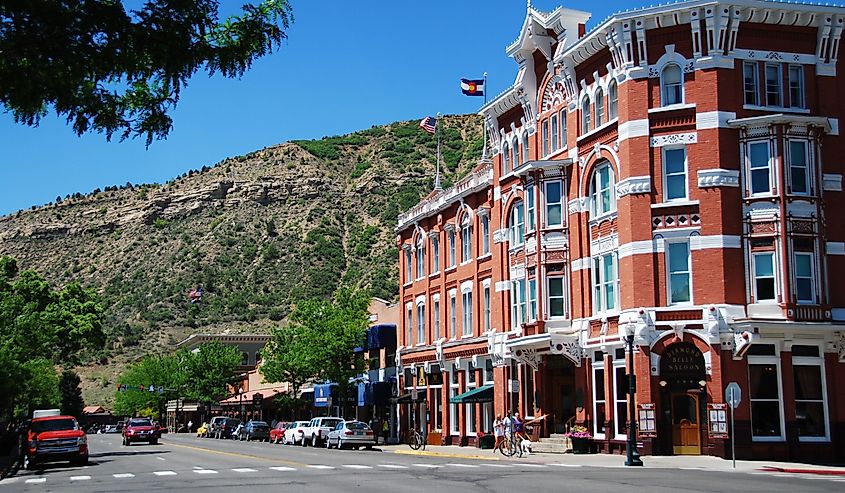
Durango, Colorado
Durango, the county seat of La Plata county, sits picturesquely along the Animas River at the base of the San Juan Mountains. Situated in southwestern Colorado, the town is near the famous Four Corners junction of the states of Arizona, New Mexico, Utah, and Colorado. Surrounded by an idyllic and serene landscape, and boasting over 300 days of sunshine a year, residents and visitors alike, enjoy the vast natural beauty of Durango.
Geography and Climate of Durango

Nestled in the foothills of the La Plata Mountains, Durango is at an elevation of 6,512 feet above sea level. The town covers 9.92 square miles of land area and 0.03 square miles of water area. Junction Creek, which flows into the Animas River, is the southern terminus for the Colorado trail which winds through 88 miles of the surrounding San Juan National Forest. Situated about 48 miles south of Silverton and 215 miles northwest of Albuquerque, Durango is a rural mountain community.
Durango enjoys moderate temperatures year-round with four distinct seasons. The warmest month is July when temperatures sit around 86°F and rarely climb higher than the upper 80s. The coldest month is January, with lows in the single digits. Despite varying temperatures depending on the altitude, Durango boasts a relatively mild winter with temperatures rarely dipping below zero. The average annual rainfall is 18 inches and the normal average annual snowfall is 67 inches.
Brief History of Durango

The area was originally settled by the Anasazi Indians, now called the Ancestral Puebloans, known for their impressive cliff dwellings. Founded in 1880 by the Denver & Rio Grande Railroad Company, Durango is a famous railroad town named after Durango, Mexico. Inspired by a trip to Mexico, a governor thought the two spots looked similar. The word, Durango, originating from the Basque word, "Urango," means "water town." In 1882, the opening of the Durango & Silverton Narrow Gauge Railroad was instrumental for access to the mining town of Silverton. From its founding in 1880, it grew to 2,400 within a year and doubled its population by 1910.
Population and Economy of Durango

The population of Durango at the last census was 19,413 with a trending annual growth increase. The tourism industry is a vital aspect of Durango’s economy, as well as retail, educational services, and health care. The Durango & Silverton Narrow Gauge Railroad is also instrumental to Durango’s economy. The average age of residents in Durango is 36.4 years. With an average household income of $65,424, the poverty rate is relatively high at 9.54%.
Tourist Attractions in and Around Durango
Durango and Silverton Railroad

In 1882, with the construction of the tracks to Silverton complete, the first passengers made the winding, scenic trip through the San Juan Mountains. Although it was primarily built to haul freight, tourists have long flocked to the region for the once-in-a-lifetime sights and the opportunity to explore the surrounding landscape. The narrow-gauge railway tightly winds through sheer rock faces, overtop of High Bridge, and around Horsehoe Curve, giving you plenty of opportunity to marvel at the stunning views of the Animas River Gorge. In the 1960s, it was designated a National Historic Landmark and awarded the National Historic Civic Engineering Landmark. When in the area, riding the early 1900s, vintage steam locomotive with the comfort of modern amenities, is a must.
Purgatory Resort

Founded in 1965, Purgatory Resort is one of the most family-friendly and affordable ski resorts in Colorado, offering free Power Kids skiing passes for children under 12 years of age. Located about 25 miles north of Durango in the San Juan Mountains, Purgatory has over 1,600 acres of skiable terrain with 105 trails, 11 lifts, three terrain parks, and a vertical drop of 2,029 feet. From skiing, snowboarding, and snowshoeing in the winter to mountain biking and hiking in the summer, there are a plethora of ways to enjoy the stunning views of Engineer Mountain, Twilight Peaks, and the West Needles Mountain Range. In the summer, families will enjoy lift-served mountain biking, the Alpine Slide, and the Inferno Mountain Coaster. Food and wine enthusiasts must check out the Annual Mushroom and Wine Dinner, and the Wild Mushroom Hunt, where Purgatory's expert guides will teach participants about edible versus non-edible mushrooms and techniques for finding mushrooms.
Mesa Verde National Park

Located about 35 miles west of town, Durango is the perfect base for a day trip to the historic site of Mesa Verde. The designation of a National Park in 1906 and a World Heritage Site in 1978 increased tourism to the area to marvel at the Ancient Puebloan dwellings. With over 5,000 archeological sites, which remarkably include masonry towers and farming structures, Mesa Verde is one of the best-preserved Puebloan ruins in North America. The most popular of these is the vast cliff dwellings throughout the bluffs, including the incredible Cliff Palace. The extraordinary archeological sites provide insight into the Paleo-Indian cultural traditions.
Hot Springs

Located about eight miles north of town and 15 miles south of Purgatory Resort, the newly renovated Durango Hot Springs Resort and Spa is a must for rest and relaxation while in the area. The resort features a swimming pool, cold plunge pool, and 41 thermal mineral features, including 26 natural mineral hot spring pools, eight Japanese-inspired cedar tubs, a reflexology walking path, and a rain tower. The natural mineral hot springs uniquely infuse nano-meter and micro-meter oxygen bubbles into the water, which increases the health benefits and purity. In addition to the stunning mountain views and hot springs with no sulphuric odor, there is a full complement of spa treatments and relaxation massages to choose from. A bit further up the road toward Silverton, is the Pinkerton Hot Springs, which are free for visitors to peruse. The colorful mounds are man-made rock piles created to discharge the hot water. Situated right off of US-550, you cannot miss this landmark when driving through the area.











